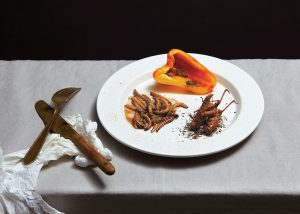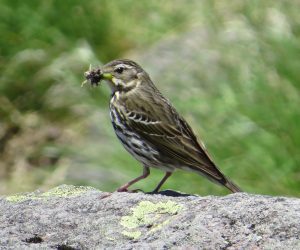
A few years ago I traveled to South Vietnam. One day, walking along a backcountry road looking for birds, which are fairly rare because the populace of rural villages eats pretty much any wild animal, a woman stooped over in front of me and snatched a big spider off the road for a quick snack. My foray into insectivory is limited to chocolate-covered grasshoppers, but two billion people around the world eat insects. In Korea boiled silkworm pupae are seasoned and eaten as a snack. Connoisseurs in Japan enjoy aquatic fly larvae sautéed in sugar and soy sauce. In the U.S. you can purchase protein bars made of cricket flour. And why not? Insects are 50-78 percent protein and 77-98 percent digestible.
With food this nutritious, it is no wonder that approximately 60 percent of the world’s birds are dedicated insectivores, surviving on arthropods. There is such a variety of exploitable arthropods that birds employ a wide array of foraging behaviors like hawking, sallying, gleaning, or probing. In temperate area winters, arthropods are scarce so permanent residents have to be flexible and find dormant insects, larvae or eggs, switch to another food source, or leave. Downy Woodpeckers probe galls or stems of plants for larvae. Northern Flickers eat ants and beetles from the ground and may take berries and seeds. Great Tits survive the winter on a regimen of berries and the seeds of beech and hazel.
Flycatchers, warblers, swallows, and swifts, dependent on active insects, migrate to the tropics where they have access to arthropods all year except at high elevations. What happens when all these insectivorous birds arrive, sometimes doubling the bird population? Insectivorous birds that are permanent residents in the tropics tend to be specialists, surviving in narrow foraging niches. For example, eleven percent of insectivorous birds in the upper Amazon basin feed only by acrobatically gleaning insects off aerial leaf litter (dead leaves hanging from understory plants), as some antthrushes and ovenbirds do. Although there are fewer dead leaves than live ones, dead leaves hold more arthropods and thus offer a higher energy yield. Migratory birds arriving in the tropics are opportunists and survive by feeding in the gaps between the residents’ foraging niches. One exception is the Worm-eating Warbler from the Eastern U.S. that winters in Central America. In the spring in the U.S. it spends about 75 percent of its time searching live leaves; on its wintering grounds it forages 75 percent of the time on dead leaves.

Insectivorous birds are important at keeping insect levels in check in forests and so reduce plant damage. Researchers in southern Sweden excluded birds from tree trunks and branches by the use of nets. After four weeks, there was a 20 percent increase in plant-eating arthropods on the protected tree parts. A similar study in a Jamaica coffee plantation resulted in a 60-70 percent increase in arthropod populations on coffee trees. Insectivores do not have as great an influence in temperate ecosystems as they do in tropical ones because cold winters keep insect populations under some control.
If you don’t want to be accused of engaging in insectivory, the proper term for humans eating bugs is entomophagy.